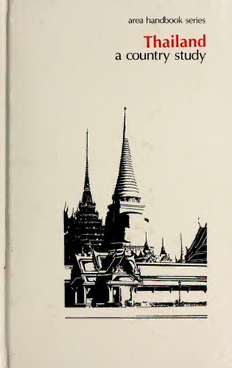Table Of Contentarea handbook series
Thailand
a country study
Thailand
a country study
Federal Research Division
Library of Congress
Edited by
Barbara Leitch LePoer
Research Completed
September 1987
On the cover: Wat Phra Keo (Temple of the Emerald
Buddha) on the grounds of the Grand Palace in Bangkok;
illustration by Teresa Kamp
Sixth Edition, First Printing, 1989.
Copyright ®1989 United States Government as represented by
the Secretary of the Army. All rights reserved.
Library of Congress Cataloging-in-Publication Data
Thailand: A Country Study
(Area handbook series) (DA Pam; 550-53)
Research completed November 1987.
Bibliography: pp. 313-346.
Includes index.
D
Supt. of Docs, no.: 101.22:550-53/987
1. Thailand. I. LePoer, Barbara Leitch, 1941-
II. Library of Congress. Federal Research Division. III. Series.
IV. Series: DA Pam; 550-53.
DS563.5.T4563 1989 959.3 88-600485
Headquarters, Department of the Army
DA Pam 550-53
ForsalebytheSuperintendentofDocuments, U.S. GovernmentPrintingOffice
Washington,D.C. 20402
Foreword
This volume is one in a continuing series of books now being
prepared by the Federal Research Division ofthe Library ofCon-
—
gress underthe Country Studies Area Handbook Program. The
last page of this book lists the other published studies.
Most books in the series deal with a particular foreign country,
describing and analyzing its political, economic, social, and national
security systems and institutions, and examining the interrelation-
ships of those systems and the ways they are shaped by cultural
factors. Each study iswritten by a multidisciplinary team ofsocial
scientists. The authors seek to provide a basic understanding of
the observed society, striving for a dynamic rather than a static
portrayal. Particular attention is devoted to the people who make
up the society, theirorigins, dominantbeliefs andvalues, theircom-
mon interests and the issues on which they are divided, the nature
and extent oftheir involvementwith national institutions, and their
attitudes toward each other and toward their social system and
political order.
The books represent the analysis ofthe authors and should not
be construed as an expression ofan official United States govern-
ment position, policy, or decision. The authors have sought to
adhere to accepted standards ofscholarly objectivity. Corrections,
additions, and suggestions for changes from readers will be wel-
comed for use in future editions.
Louis R. Mortimer
Acting Chief
Federal Research Division
Library of Congress
Washington, D.C. 20540
iii
Acknowledgments
The editor and authors are grateful to numerous individuals in
the international community, in various agencies of the United
States government, and in private organizations who gave oftheir
time, research materials, and special knowledge to provide data
and perspective for this study.
The authors also wish to express their appreciation to staffmem-
bers ofthe Federal Research Division, Library ofCongress, whose
high standards and dedication helped shape this volume. These
include Martha E. Hopkins, who managed editing and book
production, as well as editing portions of the text, Marilyn L.
Majeska, who edited parts ofthe manuscript and the accompany-
ing figures and tables, and editorial assistants Barbara Edgerton
and Izella Watson. David P. Cabitto and Kimberly A. Lord pre-
pared the book's graphics, Susan M. Lender reviewed the maps,
and ArviesJ. Staton contributed to the chartson military rank and
insignia.
The following individuals are gratefully acknowledged as well:
Ruth Nieland, Vincent Ercolano, and Mary Ann Saour for edit-
ing various chapters; Catherine Schwartzstein for the final prepub-
lication editorial review; Shirley Kessell of Communicators
Connection for preparing the index; and Malinda B. Neale ofthe
Printing and Processing Section, Library ofCongress, for photo-
typesetting, under the direction of Peggy Pixley. Special thanks
go to Teresa E. Kamp, who designed the illustrations forthe cover
of the volume and the title pages of the chapters. The inclusion
ofphotographs in this book was made possible by the generosity
of various individuals and public and private agencies.
Finally, the editor and authors wish to thank Federal Research
Division staffmembers MervinJ. Shello and Ly H. Burnham for
sharing their expertise in telecommunications and demography;
Tracy M. Henry forher assistance in word processing; Meridel M.
Jackson for her economic insights and computer expertise; and
Russell R. Ross, Robert L. Worden, and Richard F. Nyrop for
reviewing all parts of the book.
v

